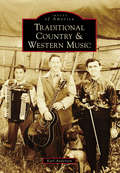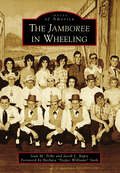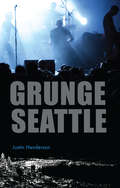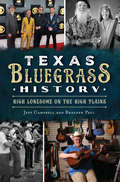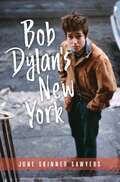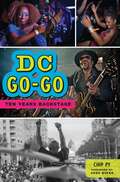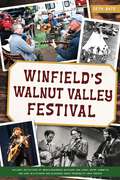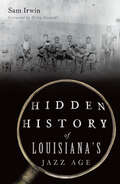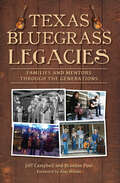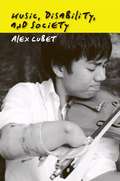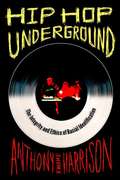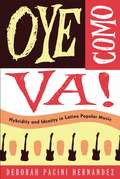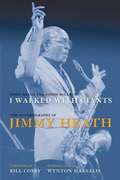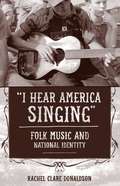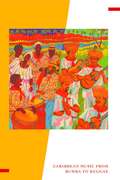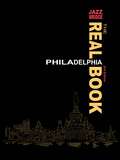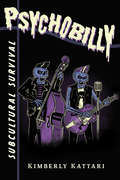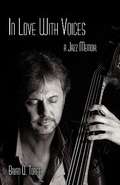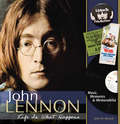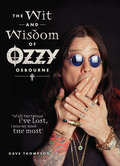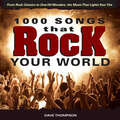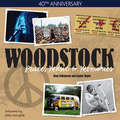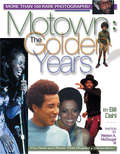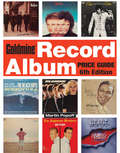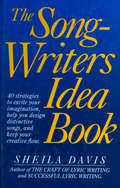- Table View
- List View
Traditional Country & Western Music (Images of America)
by Karl AndersonTraditional Country & Western Music presents historical photographs, memorabilia, and stories about an enduring music genre that took root in America from the late 1920s through the mid-1930s. Although many of our early folk songs originated from the British Isles, Jimmie Rodgers (the "Father of Country Music") and Gene Autry ("America's Favorite Singing Cowboy") became the foundation of modern country and western music. Many regional styles and variations of country and western music developed during the first half of the 20th century, including hillbilly, bluegrass, honky-tonk, rockabilly, southern gospel, Cajun, and Texas swing. Local artists, live radio shows, and regional barn dance programs provided entertainment throughout the Great Depression, World War II, and into America's postwar years. During the 1950s, country and western music became homogenized with the Nashville sound and the Bakersfield sound. By the end of the 1960s, country music completed its move to Nashville, and "western" was dropped from the equation. This book recalls the golden age of country and western music from the late 1920s through the 1960s. Each of the featured artists and programs in this book were once household names. We celebrate these early legends, live radio and television shows, unsung heroes, and local performers from Maine to California.
The Jamboree in Wheeling (Images of America)
by Ivan M. Tribe Jacob L. BapstBeginning in the mid-1920s, radio stations that catered to rural audiences sponsored programs featuring country music, generically termed "barn dances." Ranking second in terms of longevity and perhaps in significance to the Grand Ole Opry from WSM Nashville came the Jamboree in Wheeling, West Virginia. It became the springboard for such country stars as Wilma Lee and Stoney Cooper, Hawkshaw Hawkins, the Osborne Brothers, Doc and Chickie Williams, Lee Moore, Big Slim the Lone Cowboy, and most recently, Brad Paisley. Under slightly varying names, the Jamboree flourished from 1933 through 2005 over the airwaves of 50,000-watt WWVA 1170 AM and now airs on WWOV 101.1 FM.
Grunge Seattle
by Justin HendersonChronicling the intertwined lives of members of core grunge bands, Grunge Seattle reveals the origins and inspirations of the grunge movement. Delve into the collisions between personalities and egos, artists and corporations, suburbs and cities, obscurity and fame. Explore the cafés, apartments and studios where Nirvana, Pearl Jam, Soundgarden, Mudhoney and Alice in Chains practiced and played. In this reprint edition, originally published in 2010 and revised in 2016, writer, surfer and longtime Seattlite Justin Henderson provides a unique guide to the key locations in the story of grunge.
Texas Bluegrass History: High Lonesome on the High Plains
by Jeff Campbell Braeden PaulTexas has nurtured a thriving bluegrass scene since the early 1950s. The Lone Star State boasts the country's first bluegrass college degree and even hosts a Beatles bluegrass cover band. Meet the Pickin' Singin' Professor, the Fiddle Engineer and Blanco's Bluegrass Boy. Hit the trail with cowboys like the Mayfield brothers and go backstage with Grammy-nominated acts like Wood & Wire. Jeff Campbell and Braeden Paul celebrate the musicians who contributed to the harmonious heritage of Texas bluegrass.
Bob Dylan's New York
by June Skinner SawyersOn a snowy winter morning in 1961, Robert Zimmerman left Minnesota for New York City with a suitcase, guitar, harmonica and a few bucks in his pocket. Wasting no time upon arrival, he performed at the Cafe Wha? in his first day in the city, under the name Bob Dylan. Over the next decade the cultural milieu of Greenwich Village would foster the emergence of one of the greatest songwriters of all time. From the coffeehouses of MacDougal Street to Andy Warhol's Factory, Dylan honed his craft by drifting in and out of New York's thriving arts scenes of the 1960s and early ,70s. In this revised edition, originally published in 2011, author June Skinner Sawyers captures the thrill of how a city shaped an American icon and the people and places that were the touchstones of a legendary journey.
DC Go-Go: Ten Years Backstage (American Heritage)
by Chip PyDC represent! There's a party over here--there's a party over there! In go-go, the party never stops, and neither does the beat. The bands, the stars, the clubs, the spots, the sweat, the late nights and the passion are the sound of the city--all photographically captured and preserved right here. For those who know go-go, this book is a documentary celebration. Shout yourself out with a special photographic section dedicated to the fans. For those who don't know, this book is a peek into that world through the lens of Chip Py. Once Chuck Brown's photographer, his collection of images is now part of the People's Archive at the DC Public Library. Discover the District's distinctive music, its artists, its culture and why go-go has become "the official music of Washington, DC."
Winfield's Walnut Valley Festival
by Seth Bate Dan Crary Beppe Gambetta John McCutcheon Orin FriesenLocal historian Seth Bate tells the story of the Walnut Valley Festival with reflections from staff, emcees, performers, campers, and characters from throughout its history.The Festival was launched in 1972 when a guitar maker, a farmer, and a businessman built their own music festival from the ground up. It has made the small town of Winfield into an annual destination for acoustic musicians and music lovers from around the world and it has always been participatory, with the informal campsite pickin' as much a part of the event as the stage shows and instrumental contests. The Walnut Valley Festival has always been proud of its deep-rooted traditions, but most of all, it is a community celebration.
Hidden History of Louisiana's Jazz Age
by Sam IrwinStep backstage in this look at little-known and utterly fascinating aspects of Jazz Age Louisiana.New Orleans' early jazz greats like Louis Armstrong, Jelly Roll Morton, Kid Ory and Buddy Bolden had fascinating careers, but Hidden History of Louisiana's Jazz Age is filled with tales of murder, lust and adventure. Clarinetist Joe Darensbourg of Baton Rouge ran away and joined the circus three times before the age of 20. The Martel Band of Opelousas witnessed a legal public hanging of a convicted serial murderer in 1923 Evangeline Parish. Trumpeter Evan Thomas of Crowley could have been a rival to Satchmo but was cut down on the bandstand in the Promised Land neighborhood of Rayne, La. Author Sam Irwin explores the odd and quirky in these fascinating stories of the Roaring Twenties.
Texas Bluegrass Legacies: Families and Mentors through the Generations
by Jeff Campbell Braeden PaulEnjoy a breakdown of the Lone Star State's generational bluegrass harmonies. From the moment they picked up the radio signal of Bill Monroe's mandolin, Texans have been enamored with this uniquely American style of music. But the high lonesome sound couldn't have put down roots without a tradition of mentorship that runs through families and spans generations. Meet the Van Cliburn piano prodigy that became a multi-instrumentalist for Taylor Swift. Travel to the summer bluegrass camp where students develop into teachers. Sit in on a back porch jam session with the Rogers, the Brocks, the Vestals and the Whites. From the state's first Asian-American bluegrass family to its banjo-building Santa Claus, Jeff Campbell and Braeden Paul set the stage for the stewards of Texas bluegrass.
Music, Disability, and Society
by Alex LubetMusical talent in Western culture is regarded as an extraordinary combination of technical proficiency and interpretative sensitivity. In Music, Disability, and Society, Alex Lubet challenges the rigid view of technical skill and writes about music in relation to disability studies. He addresses the ways in which people with disabilities are denied the opportunity to participate in music. Elaborating on the theory of "social confluence," Lubet provides a variety of encounters between disability and music to observe radical transformations of identity. Considering hand-injured and one-handed pianists; the impairments of jazz luminaries Django Reinhardt, Horace Parlan, and "Little" Jimmy Scott; and the "Blind Orchestra" of Cairo, he shows how the cultural world of classical music contrasts sharply with that of jazz and how musicality itself is regarded a disability in some religious contexts. Music, Disability, and Society also explains how language difference can become a disability for Asian students in American schools of music, limiting their education and careers. Lubet offers pungent criticism of the biases in music education and the music profession, going so far as to say that culture disables some performers by adhering to rigid notions of what a musician must look like, how music must be played, who may play it, and what (if any) is the legitimate place of music in society. In Music, Disability, and Society, he convincingly argues that where music is concerned, disability is a matter of culture, not physical impairment.
Hip Hop Underground: The Integrity and Ethics of Racial Identification
by Harrison Anthony KwameRace and authenticity in America, explored through the Bay Area's multiracial underground hip hop scene
Oye Como Va!: Hybridity and Identity in Latino Popular Music
by Hernandez Deborah PaciniListen Up! When the New York-born Tito Puente composed "Oye Como Va!" in the 1960s, his popular song was called "Latin" even though it was a fusion of Afro-Cuban and New York Latino musical influences. A decade later, Carlos Santana, a Mexican immigrant, blended Puente’s tune with rock and roll, which brought it to the attention of national audiences. Like Puente and Santana, Latino/a musicians have always blended musics from their homelands with other sounds in our multicultural society, challenging ideas of what "Latin" music is or ought to be. Waves of immigrants further complicate the picture as they continue to bring their distinctive musical styles to the U. S. -from merengue and bachata to cumbia and reggaeton. In Oye Como Va!, Deborah Pacini Hernandez traces the trajectories of various U. S. Latino musical forms in a globalizing world, examining how the blending of Latin music reflects Latino/a American lives connecting across nations. Exploring the simultaneously powerful, vexing, and stimulating relationship between hybridity, music, and identity, Oye Como Va! asserts that this potent combination is a signature of the U. S. Latino/a experience.
I Walked with Giants: The Autobiography of Jimmy Heath
by Heath Jimmy Mclaren JosephComposer of more than 100 jazz pieces, three-time Grammy nominee, and performer on more than 125 albums, Jimmy Heath has earned a place of honor in the history of jazz. Over his long career, Heath knew many jazz giants such as Charlie Parker and played with other innovators including John Coltrane, Miles Davis, and especially Dizzy Gillespie. Heath also won their respect and friendship. In this extraordinary autobiography, the legendary Heath creates a “dialogue” with musicians and family members. As in jazz, where improvisation by one performer prompts another to riff on the same theme, I Walked with Giants juxtaposes Heath’s account of his life and career with recollections from jazz giants about life on the road and making music on the world’s stages. His memories of playing with his equally legendary brothers Percy and Albert (aka “Tootie”) dovetail with their recollections. Heath reminisces about a South Philadelphia home filled with music and a close-knit family that hosted musicians performing in the city’s then thriving jazz scene. Milt Jackson recalls, “I went to their house for dinner…Jimmy’s father put Charlie Parker records on and told everybody that we had to be quiet till dinner because he had Bird on…. When I [went] to Philly, I’d always go to their house. ” Today Heath performs, composes, and works as a music educator and arranger. By turns funny, poignant, and extremely candid, Heath’s story captures the rhythms of a life in jazz.
"I Hear America Singing": Folk Music and National Identity
by Rachel Clare DonaldsonFolk music is more than an idealized reminder of a simper past. It reveals a great deal about present-day understandings of community and belonging. It celebrates the shared traditions that define a group or nation. In America, folk music--from African American spirituals to English ballads and protest songs--renders the imagined community more tangible and comprises a critical component of our diverse national heritage. In "I Hear America Singing," Rachel Donaldson traces the vibrant history of the twentieth-century folk music revival from its origins in the 1930s through its end in the late 1960s. She investigates the relationship between the revival and concepts of nationalism, showing how key figures in the revival--including Pete Seeger , Alan Lomax, Moses Asch, and Ralph Rinzler--used songs to influence the ways in which Americans understood the values, the culture, and the people of their own nation. As Donaldson chronicles how cultural norms were shaped over the course of the mid-twentieth century, she underscores how various groups within the revival and their views shifted over time. "I Hear America Singing" provides a stirring account of how and why the revivalists sustained their culturally pluralist and politically democratic Americanism over this tumultuous period in American history.
Caribbean Currents: Caribbean Music from Rumba to Reggae (Studies In Latin America And Car)
by Peter Manuel Michael LargeyFirst published in 1995, Caribbean Currents has become the definitive guide to the distinctive musics of this region of the world. This third edition of the award-winning book is substantially updated and expanded, featuring thorough coverage of new developments, such as the global spread of reggaeton and bachata, the advent of music videos, the restructuring of the music industry, and the emergence of new dance styles. It also includes many new illustrations and links to accompanying video footage. <P><P> The authors succinctly and perceptively situate the musical styles and developments in the context of themes of gender and racial dynamics, sociopolitical background, and diasporic dimensions. Caribbean Currents showcases the rich and diverse musics of Cuba, Puerto Rico, the Dominican Republic, Jamaica, Trinidad, the French Caribbean, the lesser Antilles, and their transnational communities in the United States and elsewhere to provide an engaging panorama of this most dynamic aspect of Caribbean culture.
The Real Philadelphia Book
by Jazz BridgeThe Real Philadelphia Book, compiled by Jazz Bridge and editors David Dzubinski and Suzanne Cloud, is a collection of more than 200 original jazz and blues compositions. Arranged alphabetically by song title, the sheet music showcases work by generations of Philadelphia musicians. This volume, which is “what every aspiring jazz musician needs to know,” features tunes from Grammy Award-winners Jimmy Heath, Grover Washington, Jr., and Christian McBride, as well as legends such as Joey DeFrancesco, Ray Bryant, and Robin and Duane Eubanks. Also included are rare compositions by jazz greats Bobby Timmons, Hank Mobley, and Lee Morgan, in addition to music by local luminaries, Rhenda Fearrington, Monnette Sudler, and Kaylé Brecher. The aim of The Real Philadelphia Book is to help the jazz community make deeper, stronger connections while also formally documenting much of the important music created in the Philadelphia metro area by both well- and lesser-known musicians. Including an index of composers, The Real Philadelphia Bookwill enhance and add to the rich Philadelphia jazz and blues tradition and make the Philly jazz catalogue more easily available to musicians, jazz students and educators around the world.
Psychobilly: Subcultural Survival
by Kimberly Kattari“I got 1-2-3-4 psychobilly DNA”—Norm and the Nightmarez Call it punk rockabilly with science-fiction horror lyrics. The outsider musical genre known as psychobilly, which began in 1980s Britain, fuses punk, heavy metal, new wave, and shock rock with carnivalesque elements. The participants in this underground scene sport coffin tattoos and 1950s fashions. Bands such as The Meteors, Nekromantix, and Demented Are Go play with a wild energy and a fast tempo. Sometimes fake blood runs down a performer’s mouth. Psychobilly is ethnomusicologist Kimberly Kattari’s fascinating, decade-long study of this little-known anti-mainstream genre. She provides a history and introduces readers to the core aspects of the music as she interviews passionate performers and fans. Kattari seeks to understand how psychobilly so strongly affects—and reflects—its participants’ lives and identities so strongly. She observes that it provides not only a sense of belonging but a response to feelings and experiences of socio-economic marginalization and stigmatization. Psychobilly shows how this subculture organized around music furnishes an outlet for members to resist normative expectations and survive; they adhere to their own rules by having a good time while going through a hard time.
In Love With Voices: A Jazz Memoir
by Brian Q. TorffIn his memoir, Torff takes us beyond the music by adding depth with his vision of American music, and paints vivid portraits of the musicians with whom he played.
John Lennon - Life is What Happens: Music, Memories, and Memorabilia
by John BorackREAL LOVE...John Lennon - Life is What Happens celebrates the life and times of one of the most influential musicians in pop music history. A singer, songwriter, artist, social activist, husband and father, Lennon's genius inspired a generation-and continues to do so today some 30 years after his death.This fascinating read features more than 500 photographs and rare images of Lennon juxtaposed by the myriad pop-culture memorabilia created from the height of Beatlemania into the late 1970s and the Plastic Ono Band. Chronicling his musical career, the book includes hundreds of classic photographs, dozens of quotes by and about Lennon, and personal reminiscence from fans and celebrities recalling Lennon's impact on their lives.
The Wit and Wisdom of Ozzy Osbourne
by Dave ThompsonAll Aboard the Crazy TrainThis is Ozzy Osbourne in all his raw and unfiltered glory; four decades worth of his best quotes, oddest observations, risqué retorts, and yes, even articulate ponderings. Ozzy might come across as a nutter (and rightly so), but when you sit down and seriously consider what he's saying . . . well, he's f**king Ozzy Osbourne and he's got things to say!The Prince of Darkness sounds off on various topics including:Black Sabbath: "We thought, Let's scare the whole f**king planet with music."Drugs and Alcohol: "I was always a miserable drunk."Rehab: "I still take medication, but not for fun."Himself: "I don't know who Ozzy is. I wake up a new person every day."The Wit & Wisdom of Ozzy Osbourne reveals Ozzy's philosophy of life and reflects the spirit of the man who made Black Sabbath famous, Christian groups frightened, and The Osbournes–a hit reality TV show.
1000 Songs that Rock Your World: From Rock Classics to one-Hit Wonders, the Music That Lights Your Fire
by Dave Thompson1000 Songs That Rock Your World is the ultimate visual guide to the best rock music ever produced. From Abba to ZZ Top, it's not simply the ideal playlist, it's a one-stop catalog of a half-century of Rock 'n' Roll. Showcasing songs by nearly 500 artists in all rock genres, 1000 Songs That Rock Your World goes behind the scenes to uncover the fascinating story of the creation, significance, and popularity of these dynamic hits. More than 500 eye-popping color photos of concert action shots, album covers, posters, tickets, guitars, and more. Indexed by ranking, artist, and year for easy reference. Featuring: Buddy Holly The Beatles Elvis Jimi Hendrix The Beach Boys The Rolling Stones Lou Reed The Grateful Dead The Who The Allman Brothers Simon & Garfunkel Bob Dylan Queen Pink Floyd Led Zeppelin Neil Young Bruce Springsteen Green Day and Hundreds More!
Woodstock - Peace, Music & Memories: Peace, Music & Memories
by Brad Littleproud Joanne HagueThree days that changed a generation Woodstock - Peace, Music & Memories tells a story of what Time magazine called "the greatest peaceful event in history." Celebrate the 40th anniversary of this generation-defining moment through the words and pictures of some of the 500,000 people who were at Max Yasgur's farm in 1969. Capturing the spirit of the times with its earthly look and mix of 350 color and black and white photos, Woodstock - Peace, Music & Memories features: Foreword by festival co-creator and promoter Artie Kornfeld Commentary by longtime peace activist and Woodstock insider Wavy Gravy Personal recollections and never-before-seen pictures by the people who were there Special section on Woodstock memorabilia with current values
Motown: More than 100 rare photographs
by Bill DahlThis is the book for lovers of Motown! Author and Motown historian Bill Dahl has expertly compiled this comprehensive guide to the musical combination of pop and gospel, known as Motown.This new compilation features an A-to-Z listing and biography of nearly every Motown group since its beginning in 1959. Also included are never-before-published photos from former Motown promotions guru Weldon A. McDougal III. Enthusiasts will now have a chance to own a complete encyclopedia of groups and artists, along with information about their music, including a discography and price guide. • 32-page color section containing many never-before-published photos • Complete encyclopedia of groups, artists, plus discography and price guide for all Motown acts
Goldmine Record Album Price Guide
by Martin PopoffWhether you're cleaning out a closet, basement or attic full of records, or you're searching for hidden gems to build your collection, you can depend on Goldmine Record Album Price Guide to help you accurately identify and appraise your records in order to get the best price. Knowledge is power, so power-up with Goldmine! 70,000 vinyl LPs from 1948 to present Hundreds of new artists Detailed listings with current values Various artist collections and original cast recordings from movies, televisions and Broadway 400 photos Updated state-of-the-market reports New feature articles Advice on buying and selling Goldmine Grading Guide - the industry standard
The Songwriter's Idea Book
by Sheila DavisIn her first two books, Sheila Davis classified the major song forms and enduring principles that have been honored for decades by America's foremost songwriters. Those books have become required reading in music courses from NYU to UCLA. In The Songwriters Idea Book, Davis goes one step further, giving you 40 strategies for designing distinctive songs. You'll break new ground in your own songwriting by learning about the inherent relationship between language style, personality type and the brain. You'll go, step by step, through the creative process as you activate, incubate, separate and discriminate. You'll learn to use the whole-brain techniques of imaging, brainstorming and clustering. You'll expand your skilled use of figurative language with paragrams, metonyms, synecdoche and antonomasia. You'll be challenged to design metaphors, form symbols, make puns and coin words. And, you'll learn how to prevent writer's block, increase your productivity and maintain your creative flow. Over 100 successful student lyrics from pop, country, cabaret, and theater serve as role-models to illustrate the "whole-brain" songwriting process.
